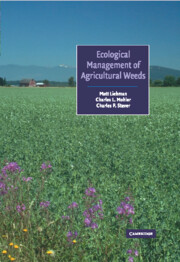Book contents
- Frontmatter
- Contents
- Preface
- 1 Weed management: a need for ecological approaches
- 2 Weed life history: identifying vulnerabilities
- 3 Knowledge, science, and practice in ecological weed management: farmer–extensionist–scientist interactions
- 4 Mechanical management of weeds
- 5 Weeds and the soil environment
- 6 Enhancing the competitive ability of crops
- 7 Crop diversification for weed management
- 8 Managing weeds with insects and pathogens
- 9 Livestock grazing for weed management
- 10 Weed evolution and community structure
- 11 Weed management: the broader context
- Taxonomic index
- Subject index
1 - Weed management: a need for ecological approaches
Published online by Cambridge University Press: 10 November 2009
- Frontmatter
- Contents
- Preface
- 1 Weed management: a need for ecological approaches
- 2 Weed life history: identifying vulnerabilities
- 3 Knowledge, science, and practice in ecological weed management: farmer–extensionist–scientist interactions
- 4 Mechanical management of weeds
- 5 Weeds and the soil environment
- 6 Enhancing the competitive ability of crops
- 7 Crop diversification for weed management
- 8 Managing weeds with insects and pathogens
- 9 Livestock grazing for weed management
- 10 Weed evolution and community structure
- 11 Weed management: the broader context
- Taxonomic index
- Subject index
Summary
Introduction
Agriculture is the process of managing plant communities to obtain useful materials from the small set of species we call crops. Weeds comprise the “other” set of plant species found in agroecosystems. Although they are not intentionally sown, weed species are well adapted to environments dominated by humans and have been associated with crop production since the origins of agriculture (Harlan, 1992, pp. 83–99).
The ecological role of weeds can be seen in very different ways, depending on one's perspective. Most commonly, weeds are perceived as unwanted intruders into agroecosystems that compete for limited resources, reduce crop yields, and force the use of large amounts of human labor and technology to prevent even greater crop losses. In developing countries, farmers may spend 25 to 120 days hand-weeding a hectare of cropland (Akobundu, 1991), yet still lose a quarter of the potential yield to weed competition (Parker & Fryer, 1975). In the USA, where farmers annually spend $6 billion on herbicides, tillage, and cultivation for weed control (Chandler, 1991), crop losses due to weed infestation currently exceed $4 billion per year (Bridges & Anderson, 1992).
At the other end of the spectrum, weeds can be viewed as valuable agroecosystem components that provide services complementing those obtained from crops. In India (Alstrom, 1990, pp. 25–9) and Mexico (Bye, 1981; Mapes, Basurto & Bye, 1997), farmers consume Amaranthus, Brassica, and Chenopodium species as nutritious foods before crop species are ready to harvest.
- Type
- Chapter
- Information
- Ecological Management of Agricultural Weeds , pp. 1 - 39Publisher: Cambridge University PressPrint publication year: 2001
- 16
- Cited by



